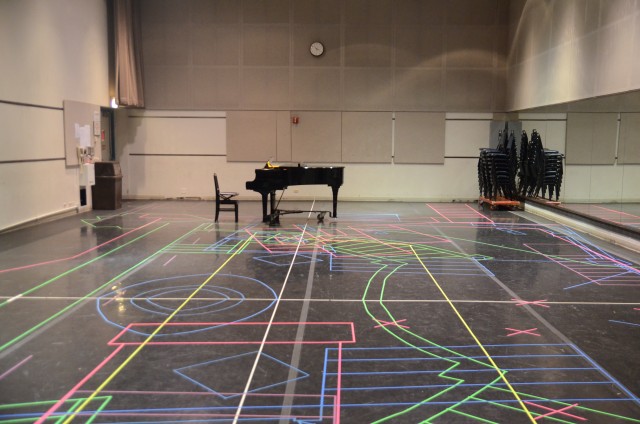
We find that singers worry endlessly about the extent to which they can move in an audition situation. A few thoughts from the other side of the table:
Should You “Block” Your Aria?
Well strictly speaking, no. You shouldn’t perform your audition in the same way you would approach a staged performance. But the exercise of staging your scene has potential to teach you things about it from which you will benefit even when you’re standing in one place. So go ahead and play with it, then figure out how to make it equally vivid without traveling all over the room, without furniture, and without props.
Please Don’t Pace
That doesn’t mean you can never take a step. If your gestures and movements are purposeful (as opposed to random and/or nervous) and completely integrated with the music and the character in both in quantity and quality, then by all means, don’t feel glued to a single spot. Do you wonder if you wander? Make a video and watch it with the sound off and the action speeded up.
Where To Stand?!?
If you’re singing an audition on a stage, there isn’t much question. But what to do in a large boxy rehearsal room with the piano at one end and the panel at the other? A surprising number of young singers tend to try to split the difference and stand in the middle of the room. But you belong near the piano, just as if you were onstage. Trust me; your collaborative pianist is better off if s/he can easily hear and see you. And we need to experience your performance as if we were in a small theatre, not your teacher’s vocal studio.
Gestures
It’s very difficult to talk about this out of context, but I think I can best contribute by describing the three types of movement that don’t work.
- Technical/Vocal. Please don’t conduct yourself, and don’t will yourself through long phrases by miming them with your arms.
- Random. If your arms look as if they belong to someone else, and their movements are not integrated in any way with what you’re communicating, we have a problem. Take every opportunity to work with movement specialists, dancers, and anyone who can help you own your physical space and be comfortable in your own skin. This skill is difficult and surprisingly uncommon.
- Semaphoric. In which you look as if you’re landing an airplane, performing ASL for the hearing impaired, or playing charades. Relax. Pay attention to how your movements illuminate your character and the storytelling. Simplicity can be extremely powerful.
Audition Props?
 I’m glad that’s settled.
I’m glad that’s settled.
It’s an Art, Not a Science
I’ve seen plenty of brilliant auditions that go much further in physicality than I would have advised in abstract, and I’ve seen unsuccessful auditions that fall well within what we would consider normal limits. Just about the time I figure out where I stand, I change my mind because someone will give a totally successful audition by doing something I didn’t advocate.
Just be aware that if you make a bold choice, it will invariably be intriguing and exciting to some panels and off-putting to others. Believe in it, and be ready to take the credit and the blame.
Add Comment